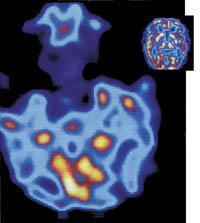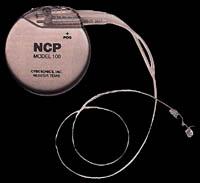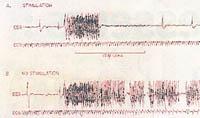Electric control for epilepsy
Before diseases like Parkinson's or Alzheimer's of greater prestige, epilepsy is the most widespread neurological mixture.
It is estimated that the number of people affected is 50 million and that in developed countries is 0.5-1% of the population. In addition, the number of patients who do not respond to any treatment is 20%. On the other hand, epilepsy drugs are less than the fingers of the hand and their relative effectiveness has not always been scientifically explained.
The Kingdom of Silence
But here is a system capable of completing epileptic seizures, even the most mischievous. By means of the electrical pulses that this device regularly sends to the brain, it controls the current discharges causing the crises, emitted by different areas of the brain. This authentic cerebral pacemaker or pacemaker is not much more expensive than epilepsy treatments.

Today the silence about epilepsy is due to the fact that very few specialized doctors, epileptologist neurologists, know little about the disease. The determinants of the disease can be more than twenty, they appear with different types of crises and although in 70% of the episodes you can know what the origin is, a place like that of the brain, can not explain the causes.
What does epilepsy science know? Little, from lifelong illness and its treatment. In children under 5 years and under 25 years the disease progresses by 20% and 59% respectively. While an epileptic may have 3 seizures a year without knowing why, another may have 100 a day.
The seizure, mostly benign, may be due to injuries or dysfunctions in a brain area (local or focal epilepsy) or sometimes (multifocal epilepsy). These areas are common in surgical interventions, as they are out of reach or because surgery could cause greater damage in case of contact with them (paralysis). Small electrical disorders of normal brain functions, discharges and all kinds of accidental short circuits trigger crises. The most general specificity of the disease is found in its symptoms and effects: in recurrent crises in which the brain momentarily loses control of the body. In most cases, all types of epilepsy have the sign that the seizure comes: "Aura", a peculiar taste, an unpleasant sensation and a tingling.
Brain injuries difficult to identify
So far this is all science knows about epilepsy. Very little! Empirically it can be said that there is more than one type of epilepsy. Observing the multiple forms of seizures, symptoms and disease, epileptologists have found that there are more than 20 types of seizures. These crises have revealed 4 types of epilepsy and 3 causes that have ruled out the existence of a single epilepsy.
But what are the causes of crises? When their origin is known, they are called symptomatic crises (30% of crises). They are related to identifiable brain injuries. The most common causes are head injuries, cranial tumors, cranial hemorrhages, saturnism or alcoholism and similar infections, meningitis and similar infections, viral encephalitis, diphtheria and, to a lesser extent, seeds, rubella and other childhood diseases.

Local or focal crises may differ from general ones. Local crises come from a certain area of the brain and, in most cases, appear with an irrational psychic behavior: muscle shaking of an arm or leg, lip gag and drifting. These crises can last a few seconds or many minutes. According to roughness, the reaction can appear in one part of the body (simple crisis of the place) or in several parts (complex crisis of the place) causing the loss of knowledge. General seizures come from areas spread on both sides of the brain and often cause huge seizures until loss of consciousness. 39% of epileptics suffer general seizures at the onset of the seizure.
Four molecules to relieve pain
Crises themselves can be classified into several categories:
- In tonic seizures, often more known, permanent muscle contraction occurs by weakening and falling legs.
- Absent crises, usually very short and difficult to observe. For a few seconds the patient loses consciousness or has a "space". They are common in childhood, even in adulthood.
- Myoclonic seizures. People suffering from these crises suffer, approximately, a minute of muscle shaking.
- Tonic-clonic crisis: The so-called "great evil" is a body that remains rigid, shaking and sometimes contracting the muscles. People suffering from these crises may lose consciousness and lose control of the globe.
This classification shows that epilepsy is a disease that causes disability and inhibition.
Crises, crisis risks, early risk of death and drug side effects are a major burden on the physical, psychic and social well-being of the patient. Those who cannot overcome the crises have difficulty going to school, getting a driver's license or maintaining the job. They develop a feeling of dependence on others, distrusting themselves. The families of the sick are questioned because the risk of dying by accident is higher than the average.
There are anti-epilepsy medicines to fight several different seizures. Although they are effective, it is not always known how and what they affect. They are basically limited to four molecules that bind sporadically: carbamazepine, balproate, phenytoin and phenobarbitol. However, these medications are not effective for certain epilepsies. On the other hand, medicines that must be taken throughout life cushion symptoms but not their causes.
Finally, the role of physicians is aimed at minimizing the perverse effects of conventional medical treatment (brain cushioning, fatigue, sleep and sleep, concentration problems...) and limiting the phenomenon of becoming accustomed to producing a constant loss of therapeutic efficacy.
No tolerance problems
Faced with this black vision, the new epilepsy treatment that has come out now, centennial later, the first, has aroused great hopes. The neuroziberetic prosthesis (NCP), presented by the American company Cyberonics, has demonstrated its effectiveness also in the most fatal epilepsis.

This device is equivalent to the pacemaker for the brain. The prestigious and demanding Food and Drug Administration (FDA) of the European Union and the United States later approved a nearby device after more than ten years of research and studies.
The NCP was first implanted in 1988. More than 1000 patients from 24 countries have received the device. Half of patients using the system have achieved an immediate reduction of 20% of crises and a reduction of more than 50% after eighteen months.
On the other hand, the system has had no perverse effects such as chronic, behavioral or emotional, nor the toxicity of the WTO. Instead of reducing its impact, it increases over time.
Risk-free and easy to implement
The treatment that leads the NCP system, called vagal nerve stimulant (VNS), emits electrical pulses every five minutes of intensity between 1.25 and 2.5 milliamperes, frequency of 30 hertz and duration of 50 nanoseconds (a nanosecond = 10-9 seconds). The device is very compact and easy to implement. It consists of a generator of 55 grams of weight and size of a pocket watch.
The NCP can be set by two cuts: the first is done in the chest at the height of the shoulder blade to insert the generator and its stack and the other in the right foot of the neck to place the electrodes in the nerve wagon. The classic "tunneling" work performed by the surgery allows the immediate attachment of the electrodes to the battery.
But why are we nervous? Especially because it controls the activity between the brain and the internal organs. It is a mixed nerve, both motor and sensory. Basically, 85% is composed of afferent fibers that emit the information from bottom to top. These fibers that extend into the central nervous system are connected to lungs, hearts, aorta, intestinal tract, and other organs. Afferent fibers send information to cortical structures (tonsils, hippocampus, cortex, etc.) known for its ability to ignite epileptic shock.

Through the afferent fibers of the vagus nerve, brain activity can be altered by acting in epileptic areas. Therefore, it can be said that SNV is a preventive treatment, since it alters the electrical activity of the brain, avoiding accidental electric shocks that cause epileptic seizures.
It is about seeing the cost of this new treatment for Social Security. With a duration of five years (the pile must be loaded) and a price of 50,000 pounds (about 1.250,000 pesetas or 7.500 euros), the cost is similar to that of conventional treatments. It is known that the Administration is more interested in filling the health bag daily than in the long term. Therefore, believing the benefits of treatment will not be so simple. But do not forget that the NCP system does not produce side effects, always harmful to the patient and costly to society.
Buletina
Bidali zure helbide elektronikoa eta jaso asteroko buletina zure sarrera-ontzian











